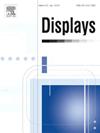The effects of vibrotactile directions and touch methods on human tactile perceptions
IF 3.7
2区 工程技术
Q1 COMPUTER SCIENCE, HARDWARE & ARCHITECTURE
引用次数: 0
Abstract
In recent years, the utilization of tactile feedback in human–computer interfaces has gained substantial attention. Among various tactile displays, vibrotactile displays are commonly regarded as the most widely used. Nevertheless, there is limited research investigating the impacts of vibration directions and touch methods on human tactile perceptions. This study aims to address this research gap by exploring the impacts of both normal and lateral vibration directions, as well as passive and active touch methods, on human tactile perceptions. Two tactile perception experiments were conducted at frequencies of 150 Hz, 200 Hz, 250 Hz, and 300 Hz. The experimental results show that for the same displacements, lateral vibrations are significantly more perceivable than normal vibrations for both passive and active touches, except at 150 Hz for passive touch. However, the normal vibrotactile perceivable thresholds are significantly lower than those for lateral vibrations for both passive and active methods. This study also surprisingly found that the most sensitive frequency for lateral vibration is around 150 Hz and 200 Hz, which is about 50–100 Hz lower than that for normal vibration. These findings can help us understand how different vibration directions and touch methods affect human tactile perception, which are important factors in designing tactile human–computer interfaces.
求助全文
约1分钟内获得全文
求助全文
来源期刊

Displays
工程技术-工程:电子与电气
CiteScore
4.60
自引率
25.60%
发文量
138
审稿时长
92 days
期刊介绍:
Displays is the international journal covering the research and development of display technology, its effective presentation and perception of information, and applications and systems including display-human interface.
Technical papers on practical developments in Displays technology provide an effective channel to promote greater understanding and cross-fertilization across the diverse disciplines of the Displays community. Original research papers solving ergonomics issues at the display-human interface advance effective presentation of information. Tutorial papers covering fundamentals intended for display technologies and human factor engineers new to the field will also occasionally featured.
 求助内容:
求助内容: 应助结果提醒方式:
应助结果提醒方式:


